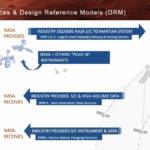WASHINGTON — The U.S. Air Force is gearing up for a demonstration next year of a satellite communications network that can seamlessly integrate government-owned and commercial constellations on a single, secure military terminal.
The demonstration is a key milestone in the Air Force Research Laboratory’s Defense Experimentation Using Commercial Space Internet, or DEUCSI — a program launched in 2018 to explore augmenting military communications by leveraging the growing commercial satellite internet industry.
The goal is to give forces on the ground, at sea and in the air access to the combined bandwidth of the military’s dedicated satellites as well as commercial satellite internet providers like SpaceX’s Starlink.
A demonstration flight, slated for 2025, will showcase newly developed communications terminals capable of tapping into multiple commercial and military satellite constellations at the same time — a capability the Pentagon currently lacks.
Security requirements
While the military already purchases commercial satcom services, it doesn’t have the ability today to integrate those commercial connections into the existing satellite architectures using a single terminal that meets DoD’s security and operational requirements, said Ron Fehlen, vice president of assured mission networks at L3Harris Technologies.
One of the prime contractors on the DEUCSI program, L3Harris has been awarded $170 million in contracts since 2021 to develop multi-orbit satellite terminals for aircraft, mobile ground systems and fixed ground stations.
The company says it is just over a year away from flight testing the technology on a military aircraft. Under its contract with AFRL, L3Harris is producing 23 terminals for fixed ground systems, two for mobile ground systems and five for aircraft.
A linchpin of the hybrid network is a modular radio developed by L3Harris called RASOR, short for Rapidly Adaptable Standards-compliant Open Radio. It houses modems that connect with multiple commercial satellite internet providers as well as dedicated military networks.
Integrating all those different modems into a single radio platform that meets stringent military security standards has been an enormous technical challenge, Fehlen said. “The modular radio brings together waveforms and modems in a flexible open architecture that can be routinely updated with new capabilities,” he said.
L3Harris said RASOR is operational and has been sold to customers for development activities outside the DEUCSI program but could not discuss further.
Future addition of new services
A key requirement for the DEUCSI terminals is an open architecture that allows new commercial satellite internet providers to be easily integrated as they come online in the future, Fehlen said. With satellite internet a booming industry, the military wants the flexibility to rapidly add new constellations that are expected to enter the market such as Amazon’s Project Kuiper broadband network.
Adam Milner, program manager at L3Harris, said the RASOR radio can scale up from three to 12 slots. The thinking in the DEUCSI program, he said, is that military forces would buy these terminals and then get routine software updates to tap into the newest commercial satellite internet services much like consumers do with smartphones.
In addition to L3Harris, the Air Force Research Laboratory selected Northrop Grumman, SES Space & Defense, and Intelsat General to develop multi-constellation satcom terminals. Each has subcontracts with several commercial satellite operators including Starlink, Viasat, OneWeb and Hughes.
Following the flight demonstration planned for late 2025, L3Harris will seek to prove out the ground-based RASOR terminals in 2026. The long-term objective is to supply an entire family of multi-orbit, multi-constellation terminals for the Army, Navy, Air Force, Marines and Space Force.
The Air Force Research Lab said the goal is to ultimately transition the technologies to operational use across the various military branches in the next two to three years if testing goes according to plan.
“Some elements of DEUCSI have already transitioned to operational use,” a spokesman for AFRL said in a statement to SpaceNews. For example, in earlier phases of DEUCSI, the lab tested single-vendor terminals from SpaceX and from a Hughes/OneWeb team. “Those systems are now available through the U.S. Space Force Commercial Satcom Office contracts and are in widespread operational use.”
Related
Author Profile
- Space.com is an online publication focused on space exploration, astronomy, skywatching and entertainment, with editorial teams based in the United States and United Kingdom
Latest entries
 ScienceMay 18, 2024It’s time to figure out global space traffic management
ScienceMay 18, 2024It’s time to figure out global space traffic management ScienceMay 12, 2024National Space Council will explore military space and intelligence roles and responsibilities
ScienceMay 12, 2024National Space Council will explore military space and intelligence roles and responsibilities ScienceMay 5, 2024NASA awards studies for commercial Mars missions
ScienceMay 5, 2024NASA awards studies for commercial Mars missions ScienceMay 4, 2024Air Force project blends military and commercial space networks
ScienceMay 4, 2024Air Force project blends military and commercial space networks

